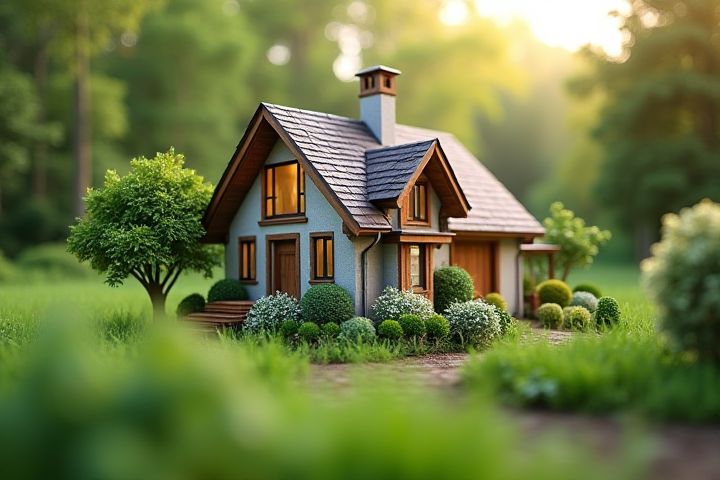
To green your house energy-efficiently, begin by upgrading insulation in walls, attics, and basements to minimize heat loss. Incorporate energy-efficient appliances, such as those labeled with ENERGY STAR certifications, to reduce electricity consumption. Consider installing solar panels to harness renewable energy, significantly lowering your utility bills while decreasing your carbon footprint. Implement smart-home technologies that optimize energy use by regulating heating, cooling, and lighting based on your daily routines. Finally, enhance your landscaping with native plants that require less water and provide natural shade, creating a more sustainable environment around your home.
How To Green A House Energy-Efficiently
Insulation upgrade
Upgrading your insulation can significantly improve your home's energy efficiency, potentially cutting heating and cooling costs by 10% to 50%. Focus on materials like spray foam or cellulose, which offer superior R-values, typically ranging from R-3.1 to R-6.5 per inch, depending on the type of insulation used. Seal any gaps or cracks around windows, doors, and ducts to prevent thermal leakage, which can account for up to 30% of energy loss. Investing in proper attic insulation can create a substantial impact, as approximately 25% of a home's heat escapes through the roof during colder months.
Energy-efficient windows
Energy-efficient windows significantly enhance your home's thermal performance by reducing heat loss in winter and heat gain in summer. These windows are typically double or triple-paned, filled with argon or krypton gas, and coated with Low-E glass to minimize UV radiation and improve insulation. Choosing energy-efficient windows can lower your heating and cooling costs, making your home more comfortable while decreasing your carbon footprint. When selecting new windows, consider Energy Star-rated options that meet strict efficiency guidelines and contribute to a sustainable living environment.
LED lighting
Switching to LED lighting can significantly reduce your energy consumption by up to 75% compared to traditional incandescent bulbs. LEDs have a lifespan of approximately 25,000 hours, meaning fewer replacements and less waste over time. By replacing just five incandescent bulbs in your home with LEDs, you could save around $100 in energy costs annually. Moreover, LED technology emits less heat, which can help lower your cooling expenses during warmer months.
Smart thermostat
Installing a smart thermostat can reduce your heating and cooling costs by up to 10-15% annually. These devices adapt to your schedule, learning your preferred temperatures and optimizing energy usage when you are away. Some smart thermostats can be controlled remotely via smartphone apps, allowing you to adjust settings in real time, even when you're not home. By integrating with other smart home devices, they can enhance overall energy efficiency, contributing to a greener household.
Solar panels
Solar panels can significantly reduce your electricity bills by converting sunlight into usable energy, typically providing a return on investment within 5 to 10 years. Installing a solar energy system on your home can decrease your carbon footprint by an average of 4 tons of CO2 per year. By utilizing net metering policies, excess energy produced can be sold back to the grid, further enhancing your savings. With the right solar panel system, you can cover up to 100% of your household's energy needs, making your home more sustainable and energy-efficient.
Energy-efficient appliances
Investing in energy-efficient appliances is key to greening your home and reducing energy consumption. Look for appliances with the ENERGY STAR label, which signifies they meet strict efficiency guidelines set by the U.S. Environmental Protection Agency. Replacing outdated devices, such as refrigerators, washing machines, and HVAC systems, not only lowers your utility bills but also lessens your carbon footprint. Consider smart appliances that optimize energy usage based on your habits, allowing significant savings while contributing to a more sustainable environment.
Water-saving fixtures
Incorporating water-saving fixtures into your home is a vital step toward enhancing energy efficiency and promoting sustainability. Low-flow showerheads and faucets significantly reduce water consumption while maintaining strong water pressure, allowing for effective usage without excessive waste. Installing dual-flush toilets can be highly beneficial, as they enable you to choose between a low-water flush for liquid waste and a full flush for solid waste, contributing to reduced water usage overall. By selecting appliances such as energy-efficient dishwashers and washing machines that utilize less water per cycle, you further minimize your household's environmental impact while also saving on utility bills.
Regular maintenance
Regular maintenance is essential for enhancing your home's energy efficiency and sustainability. Routine inspections of your heating, ventilation, and air conditioning (HVAC) system can improve performance by up to 20%. Cleaning or replacing air filters every one to three months ensures optimal airflow, reducing energy consumption significantly. Investing in a programmable thermostat can also lead to an estimated 10% savings on heating and cooling costs, allowing you to customize your energy use based on your schedule.
Weather stripping
Weather stripping can significantly enhance your home's energy efficiency by reducing air leaks and maintaining consistent indoor temperatures. By sealing gaps around doors and windows, you can improve your heating and cooling systems' effectiveness, potentially cutting energy bills by up to 20%. Select high-quality materials like silicone or foam, which provide optimal insulation and durability, ensuring long-lasting performance. Regularly inspect and replace worn or damaged weather stripping to maximize your energy savings and comfort year-round.
Energy audit
Conducting an energy audit is essential for identifying areas of energy loss and improving your home's efficiency. Start by assessing insulation levels in attics, walls, and basements, as proper insulation can reduce heating and cooling costs by 10-50%. Implementing energy-efficient appliances can lower energy consumption by 15-30%, especially when replacing older models with ENERGY STAR-rated alternatives. You can also evaluate lighting, as switching to LED bulbs can cut lighting energy use by up to 80%, enhancing overall household sustainability.
